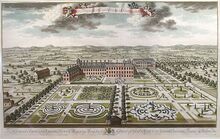Parterre

A parterre is a formal garden construction on a level surface consisting of planting beds, edged in stone or tightly clipped hedging, and gravel paths arranged to form a pleasing, usually symmetrical pattern. Parterres need not have any flowers at all. French parterres were elaborated out of 16th-century knot gardens, and reached a climax at the Chateau of Versailles and its many European imitators, such as Kensington Palace (illustration, right).
The word parterre comes from French, "on the ground" where it is used in the same sense but also has several other meanings, for example, that part of the auditorium of a theatre that may also be called in English "orchestra seats" or the "stalls".
Examples
At Kensington Palace, then a suburb of London, the planting of the parterres was by Henry Wise, whose nursery was nearby at Brompton. In the engraving of 1707/08, (illustration, right), the up-to-date Baroque designs of each section are clipped scrolling designs, symmetrical around a center, in low hedging punctuated by trees formally clipped into cones; however, their traditional 17th century layout, a broad central gravel walk dividing paired plats, each subdivided in four, appears to have survived from the Palace's former (pre-1689) existence as Nottingham House. Subsidiary wings have subsidiary parterres, with no attempt at overall integration.
In the UK, modern parterres exist at Birr Castle in Ireland, at Drumlanrig Castle in Dumfriesshire and at Bodysgallen Hall near Llandudno.
Some early knot gardens have been covered over by lawn or other landscaping, but the original traces are still visible as undulations in the present day landscape. An example of this phenomenon is the early 17th century garden of Muchalls Castle in Scotland.
Development of the parterre
The parterre was developed in France by Claude Mollet, the founder of a dynasty of nurserymen-designers that lasted deep into the 18th century. His inspiration in developing the 16th-century patterned compartimens—simple interlaces formed of herbs, either open and infilled with sand or closed and filled with flowers— was the painter Etienne du Pérac, who returned from Italy to the château of Anet, where he and Mollet were working. About 1595 Mollet introduced compartment-patterned parterres to royal gardens at Saint-Germain-en-Laye and Fontainebleau; the fully-developed scrolling embroidery-like parterres en broderie appear for the first time in Alexandre Francini’s engraved views of the revised planting plans at Fontainebleau and Saint-Germain-en-Laye in 1614 [1].

Clipped box met with resistance from garden patrons for its "naughtie smell" as the herbalist Gervase Markham described it. By 1638, Jacques Boyceau described the range of designs in box a gardener should be able to provide
- "Parterres are the low embellishments of gardens, which have great grace, especially when seen from an elevated position: they are made of borders of several shrubs and sub-shrubs of various colours, fashioned in different manners, as compartments, foliage, embroideries (passements), moresques, arabesques, grotesques, guilloches, rosettes, sunbursts (gloires), escutcheons, coats-of-arms, monograms and emblems (devises)"
—Traité du iardinage selon les raisons de la nature et de l’art, pp 81–82 (quoted by Laird)
By the 1630s, elaborate parterres de broderie appeared at Wilton House, so magnificent that they were engraved— the only trace of them that remains. Parterres de pelouse or parterres de gazon refer to cutwork parterres of low-growing herbs like camomile as much as to the close-sythed grass.
An alley of compartiment is that which separates the squares of a parterre.
Revival of the parterre
Parterre gardening was swept away, beginning in England, by the naturalistic English landscape garden, beginning in the 1720s. Its revival coincided with Neo-Renaissance architecture, in the nineteenth-century fashion for "carpet bedding" which was realized by mass planting of non-hardy flowering annuals, set out anew at the start of each season and providing the blocks of color that made up the design. Flat surfaces were required, and a raised terrace from which to view the design, and so the parterre was reborn in a transfigured style.
References
External links
- Mark Laird, in "John Evelyn's "Elysium Britannicum" and European Gardening": Dumbarton Oaks Colloquium, 1998
- An Australian Parterre
- A North American Parterre

